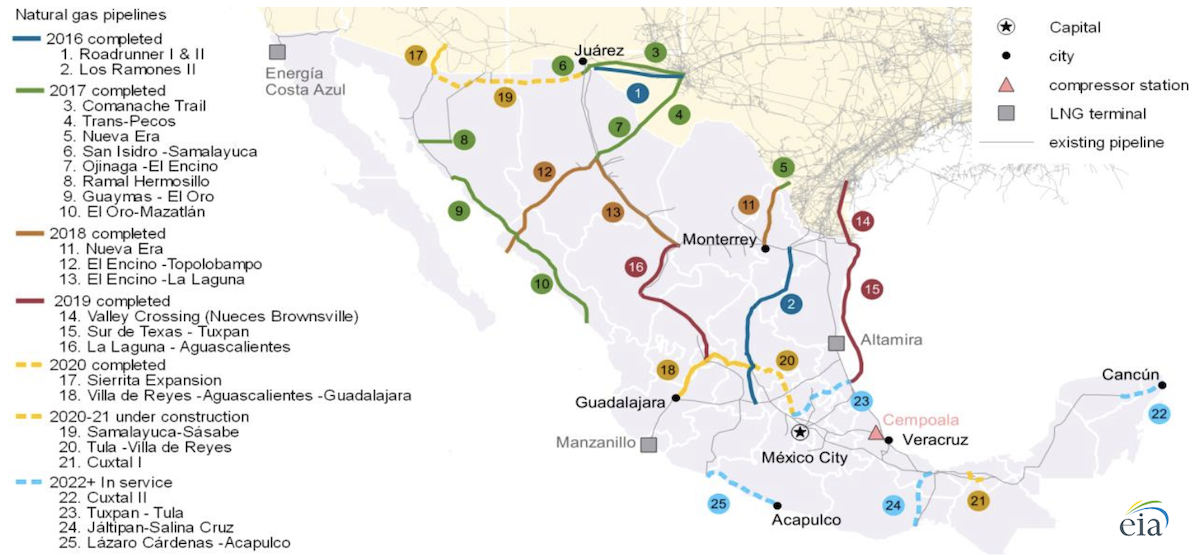U.S. natural gas exports to Mexico set to rise with completion of the Wahalajara system
Jul 06, 2020Exports of natural gas by pipeline are the largest component of U.S. natural gas trade, accounting for 40% of all U.S. gross natural gas exports in 2019. EIA expects these exports to increase with the completion of the southern-most segment of the Wahalajara system, the Villa de Reyes-Aguascalientes-Guadalajara (VAG) pipeline. VAG began operations in June 2020, connecting new demand markets in Mexico to U.S. natural gas pipeline exports.

The Wahalajara system is a group of new pipelines that connects the Waha hub in western Texas, a major supply hub for Permian Basin natural gas producers, to Guadalajara and other population centers in west-central Mexico. The Wahalajara system provides U.S. natural gas to meet growing demand from Mexico’s electric power and industrial sectors. With the 0.89 billion cubic feet per day (Bcf/d) VAG pipeline entering service, EIA expects utilization of the Wahalajara system to quickly ramp up, resulting in increased U.S. natural gas exports to Mexico out of western Texas and additional takeaway capacity out of the Permian Basin.
Since 2016, Mexico has been expanding its natural gas pipeline system, which has supported continual growth in U.S. natural gas exports. Most of this growth has been in U.S. natural gas exports from southern Texas after the existing U.S. pipeline infrastructure was expanded and the Los Ramones Phase II pipeline in central Mexico was completed.
Since the Sur de Texas-Tuxpan pipeline was completed in September 2019, U.S. natural gas exports to Mexico reached a record 5.5 Bcf/d in October 2019. U.S. natural gas exports from the border at Brownsville, Texas, to the southeastern state of Veracruz in Mexico averaged 0.6 Bcf/d during the last quarter of 2019, or about 20% of the pipeline’s capacity.
Overall, U.S. natural gas exports from this region have only increased by 0.2 Bcf/d from 2016 to 2019 because of delays in pipeline construction in Mexico. In particular, two regional pipelines were completed in 2017 but have not been used near their capacity:
- The 1.1 Bcf/d Comanche Trail pipeline, which delivers natural gas to Mexico from San Elizaro, Texas
- The 1.4 Bcf/d Trans-Pecos pipeline, which crosses the border at Presidio, Texas
The Comanche Trail pipeline has been delivering an average of 0.1 Bcf/d of natural gas to Mexico since the San Isidro-Samalayuca pipeline entered service in June 2017. Pipeline operators do not expect flows to rise until the 0.47 Bcf/d Samalayuca-Sásabe pipeline is completed in either late 2020 or early 2021 in Mexico.
The Trans-Pecos pipeline, the U.S. segment of the Wahalajara system, did not transport significant volumes of natural gas until October 2018; it is currently only operating at 10% to 15% of its total capacity. Most of the demand centers are in southern Mexico, waiting to be connected to the VAG pipeline. Three of the project’s four pipelines in Mexico that are currently in-service include
- Ojinga-El Encino: 1.4 Bcf/d, entered service in June 2017
- El Encino-La Laguna: 1.5 Bcf/d, entered service in January 2018
- La Laguna-Aguascalientes: 1.2 Bcf/d, entered service in December 2019
Before the economic impacts and uncertainty associated with COVID-19 mitigation efforts and declining crude oil prices, S&P Global Platts expected U.S. natural gas exports to Mexico to increase immediately by 0.3 Bcf/d to 0.4 Bcf/d on the Wahalajara system. However, given the decreased demand for natural gas in Mexico in response to the economic impact of COVID-19 mitigation efforts, growth is likely to be slower than expected. Beyond these volumes, additional export volumes will be limited by how quickly customers in Mexico can be connected to the pipeline system.
These connections include new natural gas-fired combined-cycle generators and the scheduled 2020 completion of the 0.89 Bcf/d Tula-Villa de Reyes pipeline, which will deliver natural gas to central Mexico. Deliveries from the Wahalajara network are likely to partially displace higher-cost liquefied natural gas (LNG) imports into Mexico’s Manzanillo terminal, which serves markets in Guadalajara and Mexico City.
As U.S. natural gas exports on the Wahalajara system rise and crude oil prices remain low, EIA expects the price at the Waha hub in the Permian Basin, which had been steeply discounted to the Henry Hub national benchmark, to continue to strengthen.
Similar Stories

U.S. Department of Energy: $20.2 million in projects to advance development of mixed algae for biofuels and bioproducts
View Article
New funding propels Pier Wind at Port of Long Beach
View Article
Most U.S. petroleum coke is exported
View Article
Paired Power installs two PairTree solar EV chargers at the Port of Hueneme
View Article
KR, HD KSOE, HD HHI, KSS Line, and Liberian Registry partner to develop safety guidelines for ship-to-ship ammonia bunkering
View Article
U.S. associated natural gas production increased nearly 8% in 2023
View ArticleGet the most up-to-date trending news!
SubscribeIndustry updates and weekly newsletter direct to your inbox!





